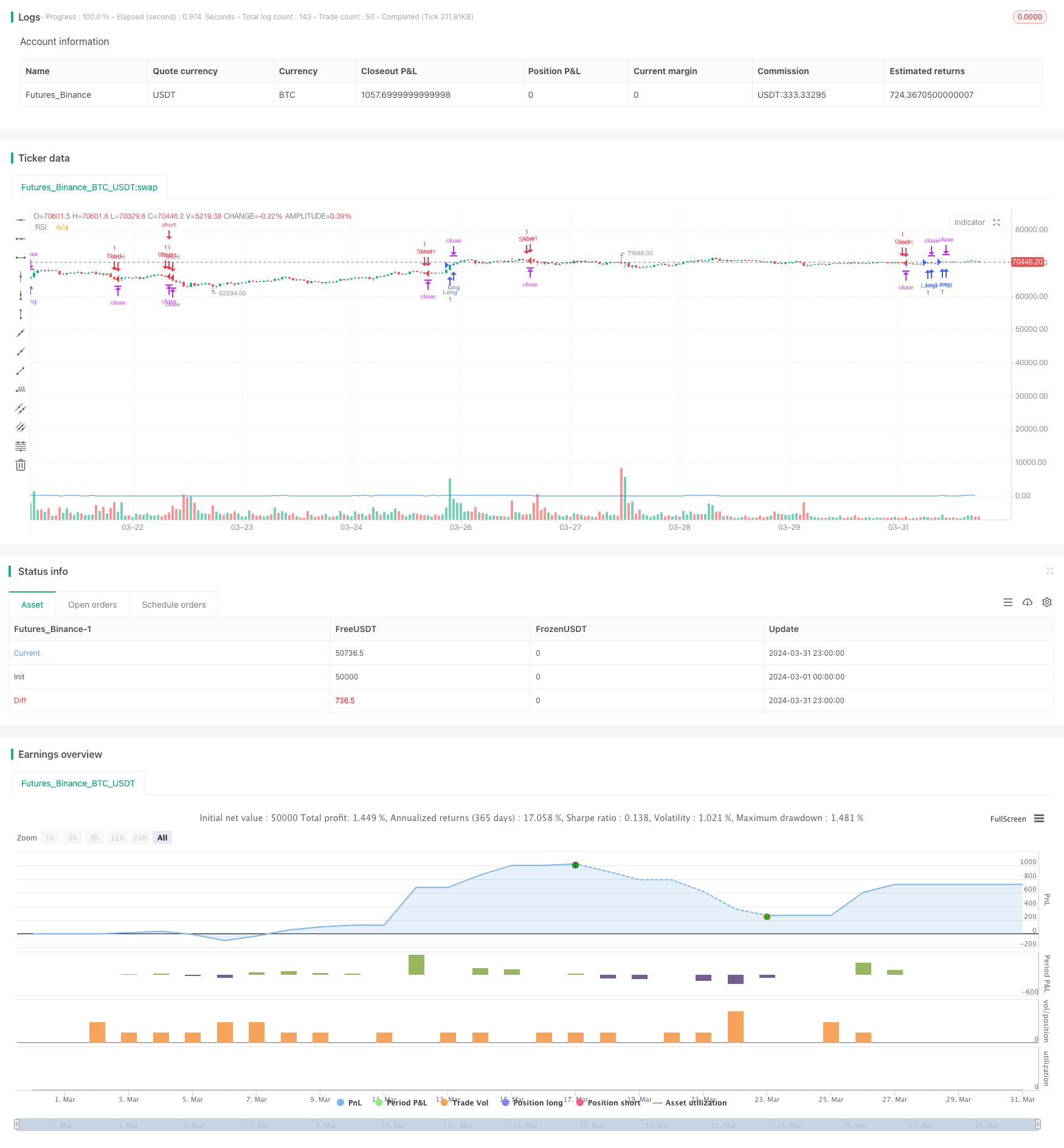
概述
该策略利用RSI指标衡量价格动量,通过计算RSI变化的标准差来确定进场时机。在RSI动量超过标准差阈值且小于前一刻动量乘以衰竭因子时开多仓,反之开空仓。该策略使用限价单平仓,通过设置止盈和止损点数来控制风险。策略在每个价格变动时执行,以捕捉所有潜在的价格波动。
策略原理
- 计算RSI指标,衡量价格动量。
- 计算RSI变化的标准差,确定进场阈值。
- 计算RSI动量,即RSI的变化量。
- 当RSI动量超过标准差阈值且小于前一刻动量乘以衰竭因子时,开多仓。
- 当RSI动量低于负的标准差阈值且大于前一刻动量乘以衰竭因子时,开空仓。
- 使用限价单平仓,设置止盈和止损点数。
- 策略在每个价格变动时执行,以捕捉所有潜在的价格波动。
策略优势
- 高频执行,能够捕捉更多的交易机会。
- 使用RSI动量和标准差阈值,能够在价格趋势明确时进场交易。
- 引入衰竭因子,避免在极端行情下进场,降低风险。
- 使用限价单平仓,能够更好地控制风险。
- 程序化交易,执行效率高,避免了人为情绪干扰。
策略风险
- 高频交易可能导致较高的交易成本。
- RSI指标可能出现钝化,导致交易信号失效。
- 标准差阈值和衰竭因子的设置需要根据市场状况进行优化,否则可能导致频繁交易或错失交易机会。
- 限价单平仓可能导致持仓时间过长,承担更多的风险。
- 策略在极端行情下可能表现不佳。
策略优化方向
- 引入更多指标,如价格行为指标,以提高交易信号的准确性。
- 优化标准差阈值和衰竭因子的设置,使其能够适应不同的市场状况。
- 引入仓位管理,根据市场波动性调整仓位大小,以控制风险。
- 考虑引入趋势过滤,在趋势明确时进行交易,避免在震荡市中频繁交易。
- 优化止盈和止损点数的设置,提高策略的盈亏比。
总结
该策略利用RSI动量和标准差阈值,在高频环境下进行反转交易。通过引入衰竭因子和限价单平仓,策略能够在控制风险的同时捕捉价格波动带来的交易机会。但是,策略在实际应用中还需要进一步优化,如引入更多指标、优化参数设置、引入仓位管理和趋势过滤等,以提高策略的稳定性和盈利能力。
策略源码
/*backtest
start: 2024-03-01 00:00:00
end: 2024-03-31 23:59:59
period: 1h
basePeriod: 15m
exchanges: [{"eid":"Futures_Binance","currency":"BTC_USDT"}]
*/
//@version=5
strategy("MCOTs Intuition Strategy", overlay=true, default_qty_type=strategy.fixed, default_qty_value=1, initial_capital=50000, calc_on_every_tick=true)
// Input for RSI period
rsiPeriod = input(14, title="RSI Period")
// Input for standard deviation multiplier
stdDevMultiplier = input(1.0, title="Standard Deviation Multiplier")
// Input for exhaustion detection
exhaustionMultiplier = input(1.5, title="Exhaustion Multiplier")
// Input for profit target and stop loss in ticks
profitTargetTicks = input(8, title="Profit Target (ticks)")
stopLossTicks = input(32, title="Stop Loss (ticks)")
// Calculate RSI
rsiValue = ta.rsi(close, rsiPeriod)
// Calculate standard deviation of RSI changes
rsiStdDev = ta.stdev(ta.change(rsiValue), rsiPeriod)
// Calculate momentum
momentum = ta.change(rsiValue)
// Conditions for entering a long position
longCondition = momentum > rsiStdDev * stdDevMultiplier and momentum < momentum[1] * exhaustionMultiplier
if (longCondition)
strategy.entry("Long", strategy.long)
strategy.exit("Take Profit Long", "Long", limit=close + profitTargetTicks * syminfo.mintick)
strategy.exit("Stop Loss Long", "Long", stop=close - stopLossTicks * syminfo.mintick)
// Conditions for entering a short position
shortCondition = momentum < -rsiStdDev * stdDevMultiplier and momentum > momentum[1] * exhaustionMultiplier
if (shortCondition)
strategy.entry("Short", strategy.short)
strategy.exit("Take Profit Short", "Short", limit=close - profitTargetTicks * syminfo.mintick)
strategy.exit("Stop Loss Short", "Short", stop=close + stopLossTicks * syminfo.mintick)
// Plotting RSI value for reference
plot(rsiValue, title="RSI", color=color.blue)
相关推荐